Guide on Probiotics for Kids (ages 0-10)
Looking for a probiotic for your little one, but are not even sure what they are? Then this guide will help you find the answers! In this comprehensive guide for probiotics for infants, babies, toddlers and kids, we cover what probiotics are and their benefits, FAQs, types of probiotics, and so much more! Great guide for 0-10 years of age.
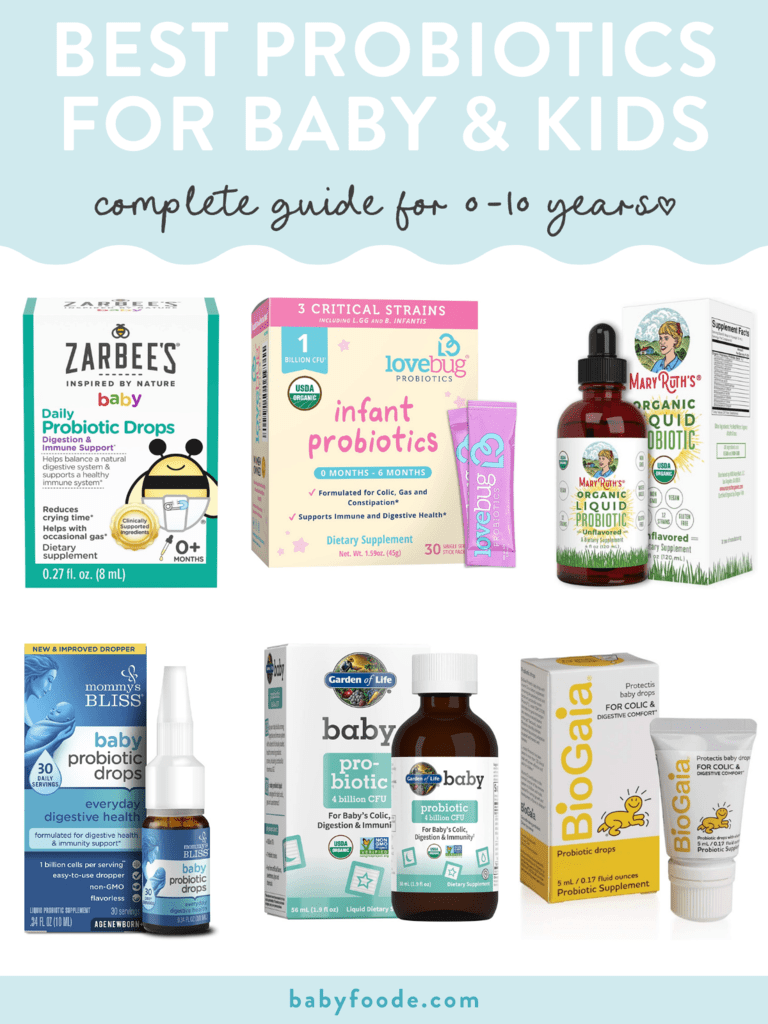
Medically reviewed and co-written by Jamie Johnson, Registered Dietitian Nutritionist (RDN), and Lauren Braaten, Pediatric Occupational Therapist (OT).
Probiotics for Kids
Looking for a probiotic for your kid, but not sure where to start?
Then look no further!
This is an in-depth guide on probiotics for your infant, baby, toddler and kids that will give you all of the answers you are looking for when it comes to probiotics and your little one. Note that I was not paid by any of these companies for these reviews. These are my honest thoughts and opinions on each of them.
Probiotic Benefits for Kids
The gut is made up of trillions of live microorganisms responsible for 80% of our immune system, so having good gut health is extremely important for your baby and toddler’s health for years to come. The gut also plays a huge role in digestion, skin health, brain chemistry, hormones, and immunity and is often referred to as a second brain.
A healthy gut makes for a healthy life!
And while you would think that baby comes into this world with a perfectly balanced little gut, that just isn’t the case. Baby’s gut bacteria (both the good and bad bacteria) is influenced by the mom’s gut health in utero, gestational age, mode of delivery, diet, and antibiotic exposure. And because of the modern world that we live in – high-stress, pre-antibiotic, nutrient-poor, and abundance of refined foods, most moms’ gut health is depleted to some extent.
So while I am wary of adding any supplements or medicine into an infant’s daily life, I am a firm believer that probiotics are a must for most (if not all) babies to help them boost their growing gut health. They are generally safe for healthy babies, but as always, consult with your pediatrician before starting any probiotic, especially if your child has serious health issues.
Frequently Asked Questions
Probiotics, or “good bacteria,” are microorganisms that live in your gut and have health benefits when consumed, like improved digestion. Probiotics are found in many fermented foods, like yogurt, kefir and sauerkraut, and eating these foods or taking a probiotic supplement may help boost the amount of beneficial bacteria in your gut. Prebiotics are the food that helps probiotics grow.
Generally yes, all brands can safely be given to healthy babies or toddlers. Keep in mind that probiotics are considered a supplement and not a medication, so are not regulated by the FDA. When choosing a probiotic for your baby and to ensure its safety, it’s best to look for one that has been certified by an independent body like ConsumerLab, USP or NSF International. Please consult your pediatrician before you start a probiotic or if you have any questions or concerns, especially if your child has a weak immune system, was born prematurely or has other health issues.
What do Probiotics Help with?
While probiotics may help infants with numerous different gut related issues, here are some of the main ones. Keep in mind that there is very little research on probiotics and infants but some clinical trials and anecdotal evidence has shown that they may be helpful for:
- easing colic
- reducing reflux
- decreasing diarrhea
- easing constipation
- eliminating gas
- skin issues – eczema, baby acne, dry or patchy skin
- improving immunity
- anti-inflammatory
- reducing the risk of early childhood obesity
- relieving a stuffy nose, respiratory infection, and trouble breathing
- reducing the risk of food intolerances and food allergies
- producing hormones, like serotonin
- improving mood, motivation, and cognitive health
- repairing damaged tissue from injuries (great for mobile babies and toddlers)
Even if your baby or toddler isn’t experiencing any of these symptoms, chances are they still could benefit from a probiotic.
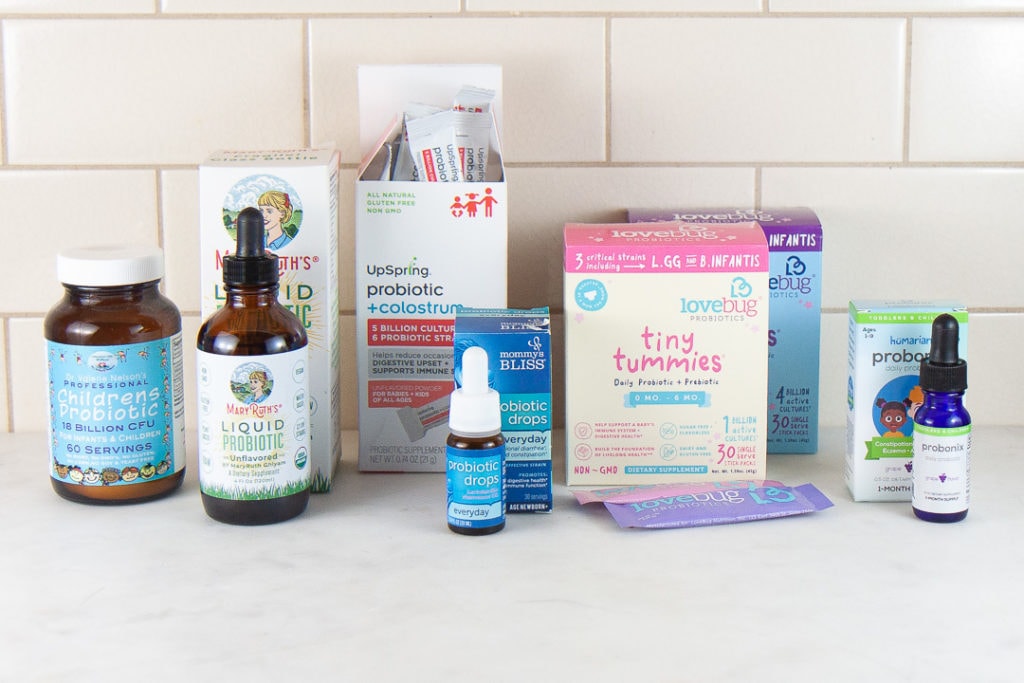
Types of Probiotics
Powder – you can sprinkle the powder onto a nipple or a pacifier or add it to a bottle of breastmilk or formula for your baby. You can add it to a glass of milk, water, or juice or mix it into yogurt or applesauce for toddlers.
Liquid – you can place the liquid drops directly into your baby’s or toddler’s tongue or add it to a bottle of breastmilk or formula for your baby or to a glass of milk, water, or juice for a toddler. You can also mix it into a serving of yogurt or applesauce for a toddler.
Formula – there are some infant formulas on the market that are fortified with probiotics
Tip: Do not add probiotics to hot liquids or foods as this will kill off the bacteria in the probiotics.
Probiotics Your Infant + Toddler Need
B.Bifidum: one of the first strains to colonize in the baby’s intestines may help build immunity and eliminate eczema.
B. Infantis: helps with immunity and reduces inflammation as the bacteria crowds the gut and makes it inhospitable to foreign invaders (bad bacteria) to populate it.
L. Rheuteri: this strain is commonly found in probiotics as studies have shown that is helps treat colic and reflux.
How Often to Give Probiotics
If your baby or toddler has any symptoms from the list above, then I would give them the dosage on the package (or per your pediatrician’s recommendations) daily.
For preventive use, I would recommend giving them to your baby or toddler several times a week, but it’s okay if you skip a couple of days a week.
Antibiotics – if your baby or toddler needs a round of antibiotics for any reason, it is essential to re-populate the good bacteria in their system as soon as the round of antibiotics is over. Antibiotics kill off all of the good and bad bacteria in the body. It’s super important to then load up on the good bacteria before the bad bacteria has a chance to reproduce. Probiotics can be given during the course of antibiotics, but make sure they are taken at different times of the day, and continue to take them for a few weeks after stopping antibiotics, or as directed by your pediatrician.
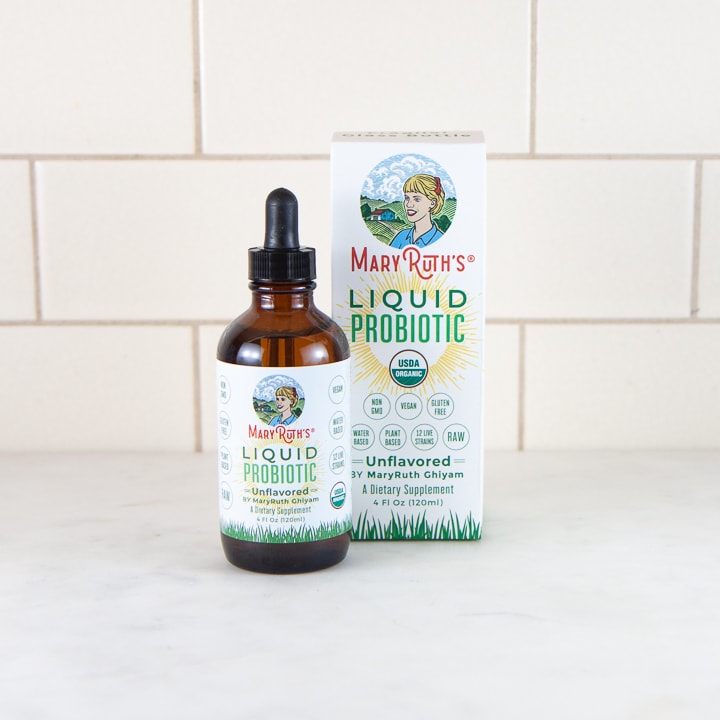
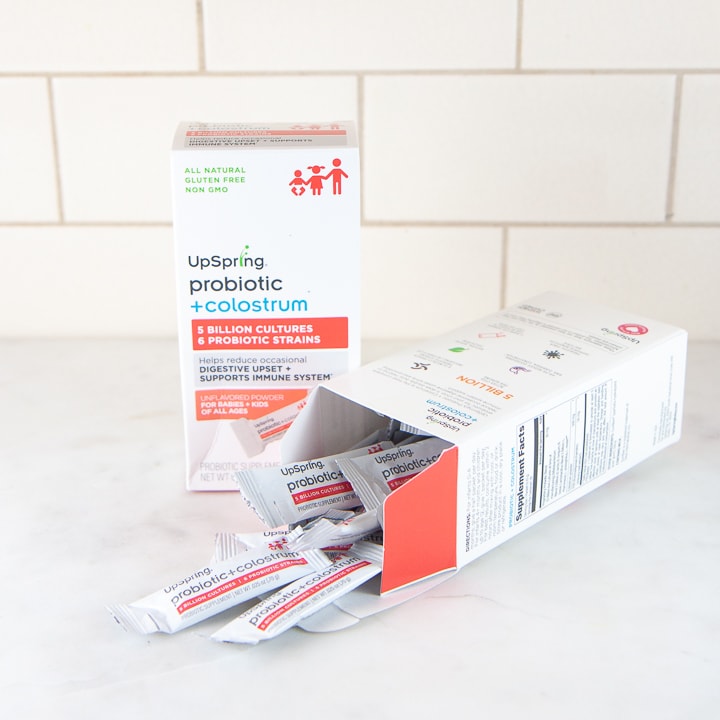
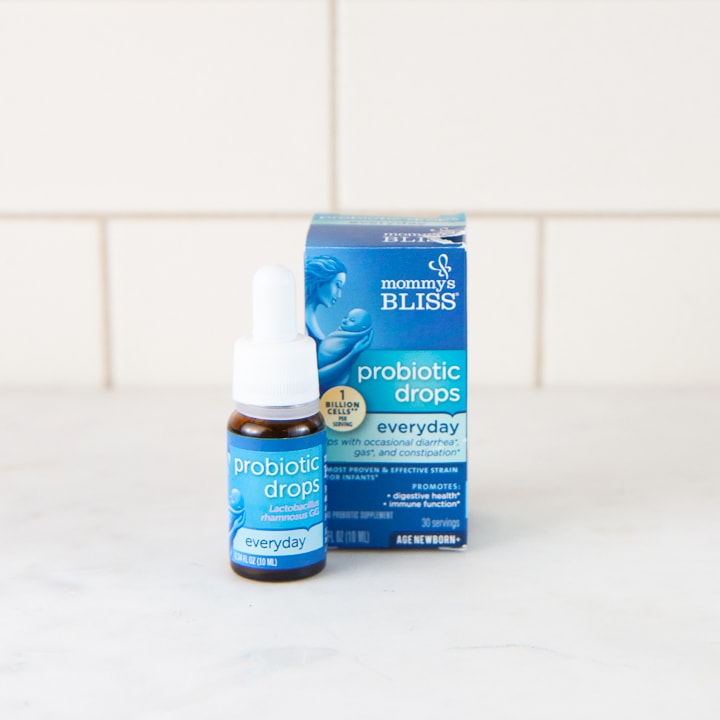
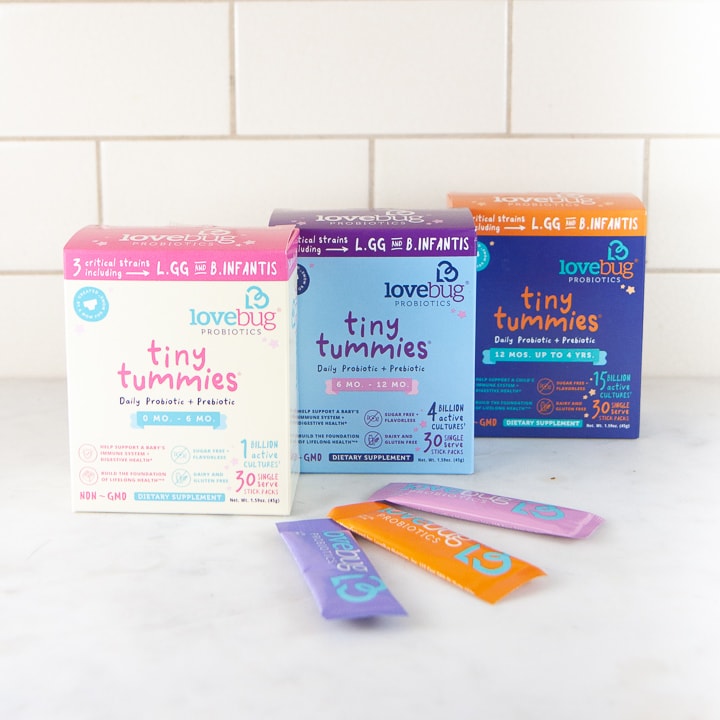

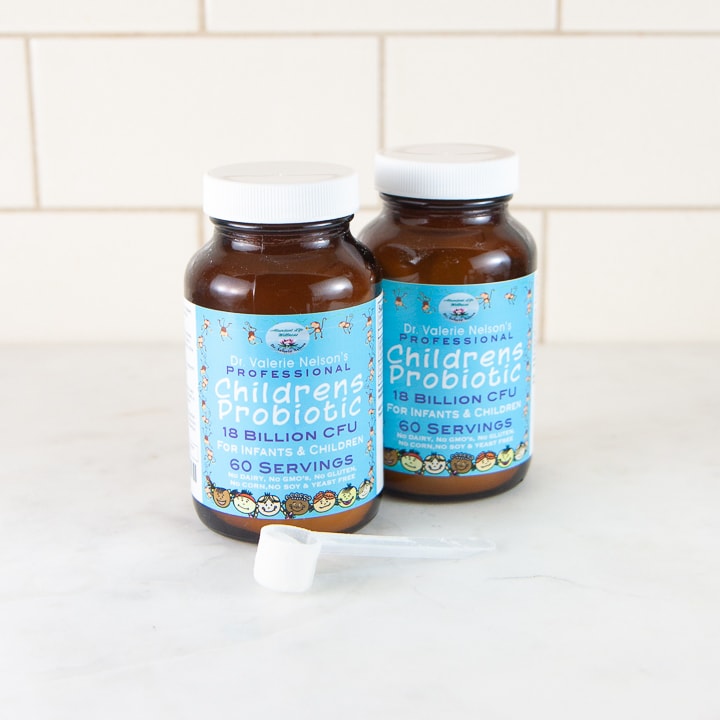
Best Probiotics for Infant & Baby
- Mary Ruth’s Liquid Probiotic
- UpSpring Probiotic with Colostrum
- Mommy’s Bliss Probiotic Drops
- Lovebug Tiny Tummies Probiotic
- BioGaia Protectis Probiotics Drops
- Zarbee’s Naturals Baby Daily Probiotic Drops
- Garden of Life Baby Probiotics – Infants, Babies & Toddlers
Best Probiotics for Kids
- Lovebug Probiotic Chews for Kids | Ages 4+
- Mary Ruth’s Probiotic Gummies
- Lovebug Tiny Tummies Probiotic
- Zarbee’s Naturals Children’s Daily Probiotic Blend
- Garden of Life Probiotics – Kids Chewables
Top Recommended Brands
We love all of the brands listed below, but here is our favorites in each category.
Best Overall Probiotic: Mary Ruth’s Liquid Probiotic
Best Prebiotic & Probiotic: Lovebug Tiny Tummies Probiotic
Best Probiotic with Immune Support: UpSpring Probiotic with Colostrum
Best for Colic: Mommy’s Bliss Probiotic Drops or BioGaia Protectis Probiotics Drops

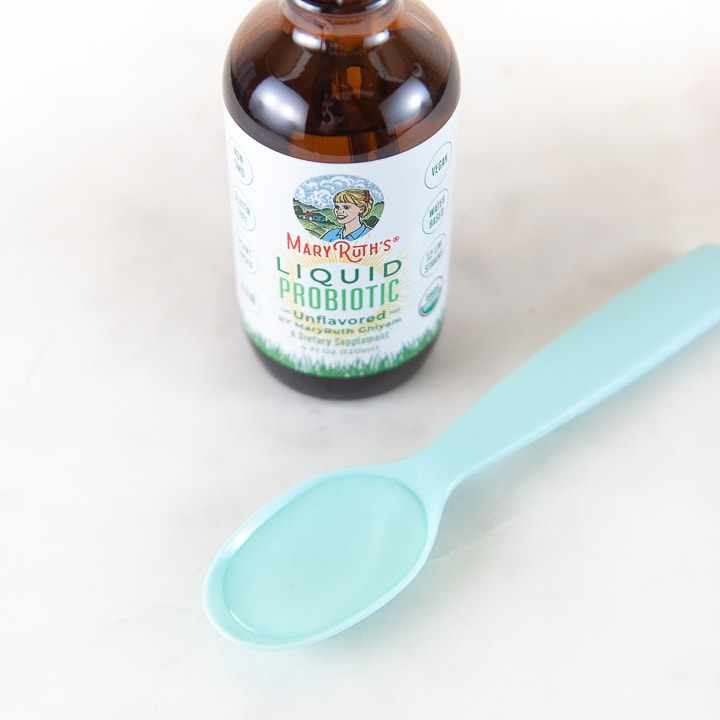
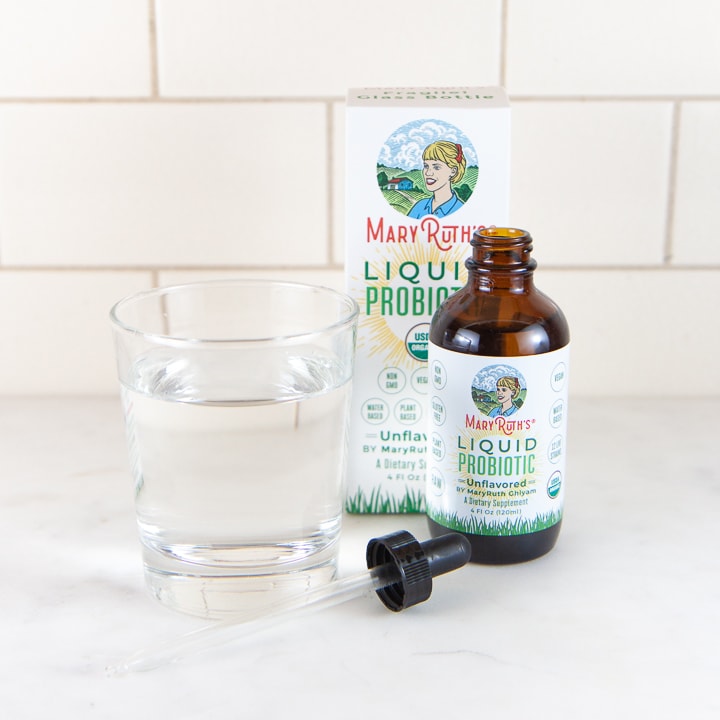
Mary Ruth’s Liquid Probiotic
Key Ingredients
- The first-ever USDA Certified Organic liquid probiotic, made without harsh chemicals, fillers, or artificial ingredients
- Non-GMO, vegan, gluten-free, water-based, and plant-based
- Contains a proprietary probiotic blend: Lactobacillus acidophilus, Lactobacillus rhamnosus, Lactobacillus salivarius, Lactobacillus casei, Lactobacillus plantarum, Lactococcus lactis, Streptococcus thermophilus, Bifidobacterium bifidum, Bifidobacterium lactis, Bifidobacterium infantis, Bifidobacterium breve, Bifidobacterium longum. Other Ingredients: Purified Water, Organic Alfalfa Grass
Why Our Experts Love it
In addition to its impressive 12 strains of probiotics, we love that Mary Ruth’s tastes like water; your baby or toddler will never know they are taking probiotics. You can mix it with water, formula, or breast milk or drop it directly into the mouth. This is our favorite overall probiotic for baby and toddler gut health. It helps with digestive problems, constipation, diarrhea, gas, bloating, IBS, and other gastrointestinal complaints.
Pros/Cons
Pros
- Long shelf life
- No refrigeration necessary
- Comes in a 4 oz bottle for everyday use, as well as a 1 oz or 2 oz bottle for travel
- Live probiotics that have not been heat-treated
Cons
- Dosages are listed for children ages 1-3 on the package; consult with your pediatrician for the correct dosage if giving to children younger than 1 year
Probiotic Products
- Mary Ruth’s Liquid Probiotic Drops – Infant
- Mary Ruth’s Liquid Probiotic Drops – Kids
- Mary Ruth’s Probiotic Gummies
Parent’s Review
I love that this works for basically the whole family. All kids willingly take this probiotic without any complaints in flavor. Helped treat my sons eczema he was dealing with. Also have relied on this heavily after my kids have been on antibiotics. Love Mary Ruth’s!!
-Brooke

Mary Ruth’s Liquid Probiotic
Support your immune system and gut health with Mary Ruth’s Liquid Probiotic. It’s formulated to help support a healthy microbiome and digestive tract with a blend of 12 probiotic strains, is certified USDA organic and vegan.

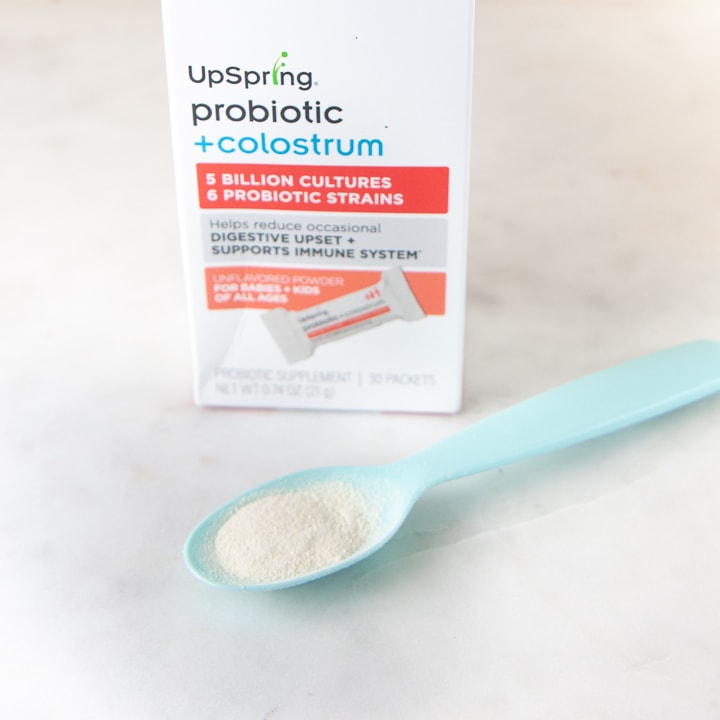

UpSpring Probiotic with Colostrum
Key Ingredients
- Each packet contains 5 billion active cultures of 6 probiotic strains, plus prebiotics and natural bovine colostrum
- Probiotic Blend – B. Lactis, B. Longum, B. Breve, Lactobacillus blend, L. Rhamnosus, L. Acidophilus, L. Reuteri, colostrum powder, FOS fructooligosaccharides and chicory root extract, Sunfiber (partially hydrolyzed guar gum), Silica. Contains milk.
- Gluten-free, sugar-free, hormone-free and no artificial ingredients
Why Our Experts Love it
This probiotic has a mild flavor and mixes great into liquids like cool water, formula, or breast milk. You can also mix it with yogurt or applesauce.
Pros/Cons
Pros
- Easy to use, single-serve packets would be great for travel or on the go
- Contains 5 billion active cultures and 6 probiotic strains
- Natural bovine colostrum
- Flavorless powder is easy to take
Cons
- Does contain milk, so if your baby or toddler is dairy-free, you will have to pick another brand
- Refrigeration is recommended but not necessary
Parent’s Review
It’s been several days, and already we’re seeing a huge difference in our 10-month-old. She has had reflux since birth and until recently continued to struggle with it. Also, every couple months we would try baby oatmeal to help with her reflux, but it caused so much constipation. Now, the last few days she has had no spit-up or food related pain that I can tell, and the truly amazing thing is that we gave her oatmeal yesterday and the day before, and today she has already pooped twice! No more issues whatsoever. Genius product.
-Lee
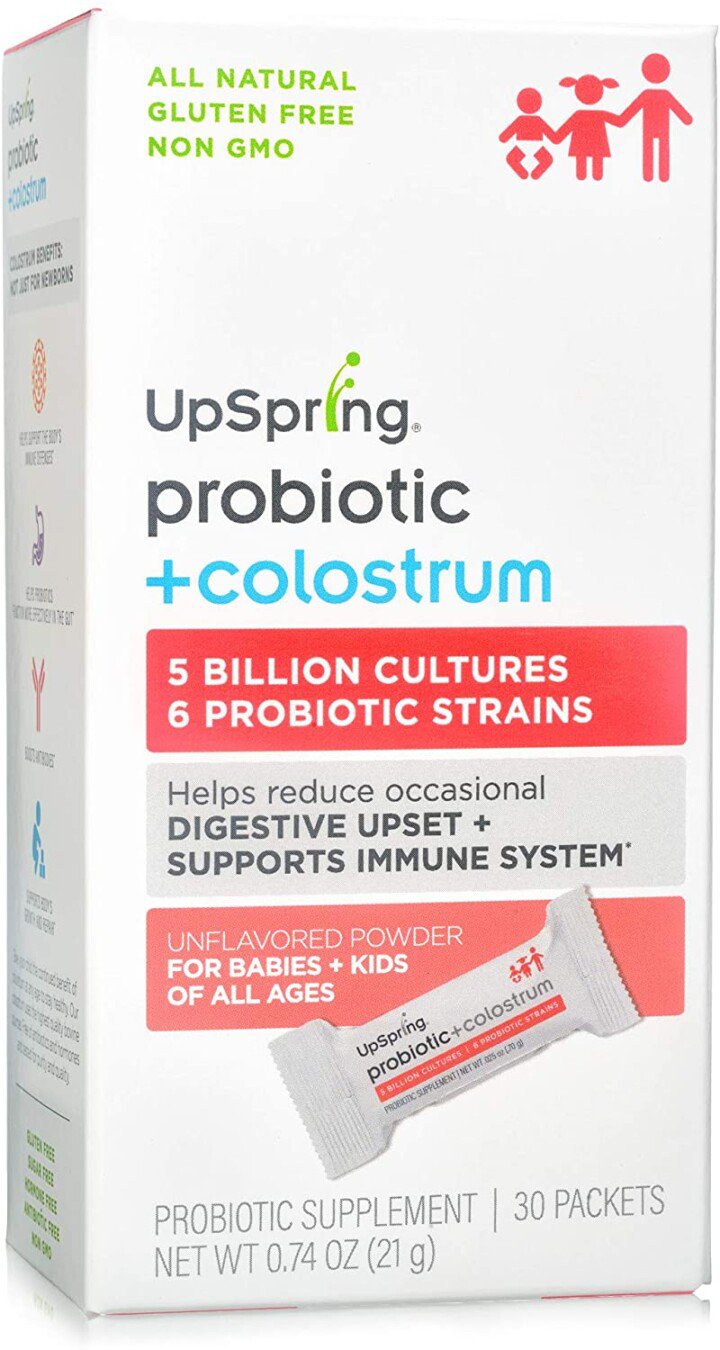
UpSpring Probiotic with Colostrum
UpSpring’s Probiotic + Colostrum does double duty, helping to reduce occasional digestive upset while also providing additional immune support. Each tiny packet contains 6 probiotic strains plus prebiotics.
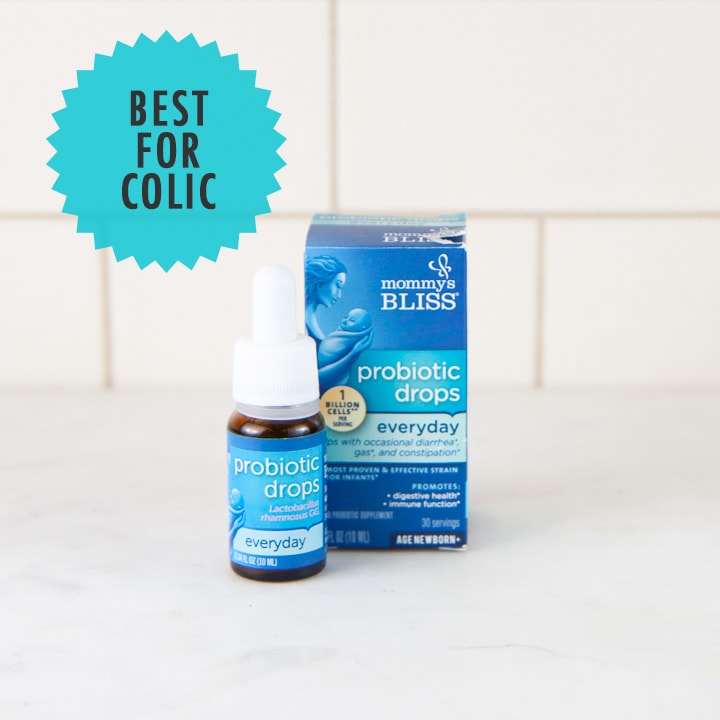


Mommy’s Bliss Probiotic Drops
Key Ingredients
- Contains pure lactobacillus rhamnosus GG, the world’s most studied single-strain probiotic, corn oil (non-GMO)
- No added sugar, no alcohol, no artificial flavors or colors
- Free of the top 8 allergens
Why Our Experts Love it
Mommy’s Bliss Probiotic drops are a daily probiotic supplement for babies that you can use from birth to help with gas and colic. While it is just a single-strain probiotic, it has lactobacillus rhamnosus, which has been clinically shown to reduce spit-up and colic by 50%. So, if your main concern is a crying and fussy baby, it may be a great option for you.
Pros/Cons
Pros
- Mild tasting
- Squeeze dropper makes it easy to provide the correct serving size
Cons
- Does have an oily base which may be difficult if using for a toddler to drink in water
- Single strain probiotics may not be as appropriate for all babies or toddlers
Parent’s Review
My son’s pediatrician gave us a sample of the Gerber probiotic. It was hard to get any of the drops out toward the end of the bottle, and I couldn’t justify paying $30 every 2 weeks for probiotics. I had good luck with Mommy Bliss brand before, so I gave these a try. I was pleasantly pleased! Second time I’ve bought these probiotics and helps with my 6 month old’s entire digestive system. He struggled from reflux and constipation, and s
-Ashley
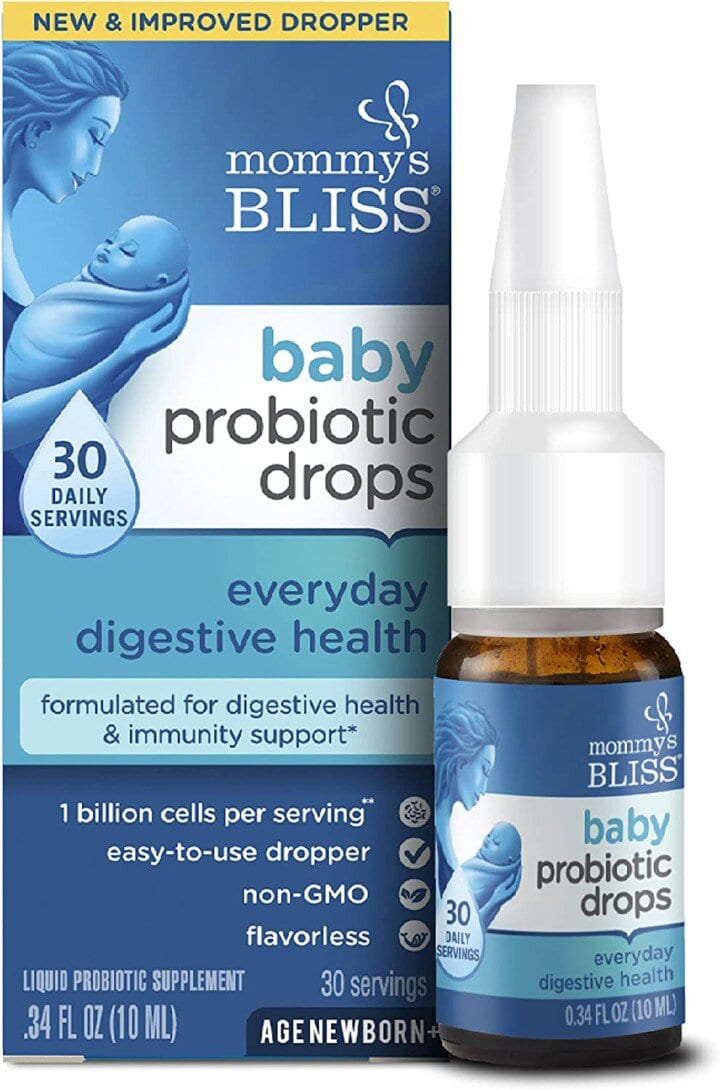
Mommy’s Bliss Probiotic Drops
Mommy’s Bliss top-selling Baby Probiotic Drops supports digestive health and immunity for your baby every day.



Lovebug Tiny Tummies Probiotic
Key Ingredients
- Contains a proprietary blend of top probiotic strains – Bifidobacterium infantis, Bifidobacterium lactis, Lactobacillus rhamnosus GG, Chicory Fructooligosaccharides, and Silica
- Contains added prebiotics
- Non-GMO, allergen-free, sugar-free, and no artificial colors or flavors
Why Our Experts Love it
We love that Tiny Tummies is a staged product that adds more probiotics as your child grows. It’s available for infants to 4 years in 3 different stages (0-6 months, 6-12 months, and 1-4 years). We also appreciate the added prebiotics, which helps probiotics grow.
Pros/Cons
Pros
- Flavorless, pre-portioned stick packs to ensure potency and freshness
- Mild tasting, easily mixable in water, formula, breast milk, yogurt or applesauce
- No refrigeration needed
Cons
- More expensive compared to other brands
Probiotic Products
- Lovebug Probiotic for Infants | Ages 0 – 6 Months
- Lovebug Probiotic for Babies | Ages 6 – 12 Months
- Lovebug Probiotic for Toddlers & Kids | Ages 12 Months to 4 Years
- Lovebug Probiotic Chews for Kids | Ages 4+
Parent’s Review
Since birth our breastfed baby has been extremely gassy with no improvement from mommy diet modifications and only minor improvements with gas drops, massage, and gas passed devices. Desperate to help him we decided to try these and SO glad we did. Days 2-4 yielded more gas as the bacteria in his gut was changing but by day 5 our 8wk old is finally taking 2-2.5hr *solid* naps…no longer waking up screaming with gas pain! If your at your wits end with a gassy baby, try this product!
-Tia

Lovebug Tiny Tummies Probiotic
Lovebug Tiny Tummies Probiotic supports a healthy digestive system during the early stages of development and immune health.

BioGaia Protectis Probiotics Drops
Key Ingredients
- Contains L. reuteri Protectis, shown to reduce crying and fussing in colicky babies
- Also contains sunflower oil and medium chain triglyceride oil (non-GMO, natural palm kernel oil)
- Non-GMO ingredients, no artificial colors, flavors, dairy or soy
Why Our Experts Love it
BioGaia Protectis is safe and effective for newborns and up. These baby drops have been clinically shown to ease colic, spit-ups, and occasional constipation and diarrhea.
Pros/Cons
Pros
- Easy to remember dosing – 5 drops regardless of baby’s age
- Flavorless drops can be mixed with breastmilk, formula or food that is at or below body temperature
Cons
- More expensive compared to other brands
- Recommended to use within 3 months of opening
Parent’s Review
This probiotic made a HUGE difference in our infants life. He was struggling with reflux, gas pains, and colic. We tried another probiotic, gas drops, colic calm, gripe water, bicycle kicks, sensitive formula, upright for 15 minutes after pace eating, literally all the things. It was miserable so I looked at this probiotic, read the reviews and decided to give it a try. Not kidding you within a day our 6 week old was pooping regularly with minimal gas pain. I would recommend this if you’re like me and tried it all. Glad I found it!
-Jeri

BioGaia Protectis Probiotics Drops
BioGaia Protectis baby drops are the original baby probiotic drops for colic and digestive comfort.
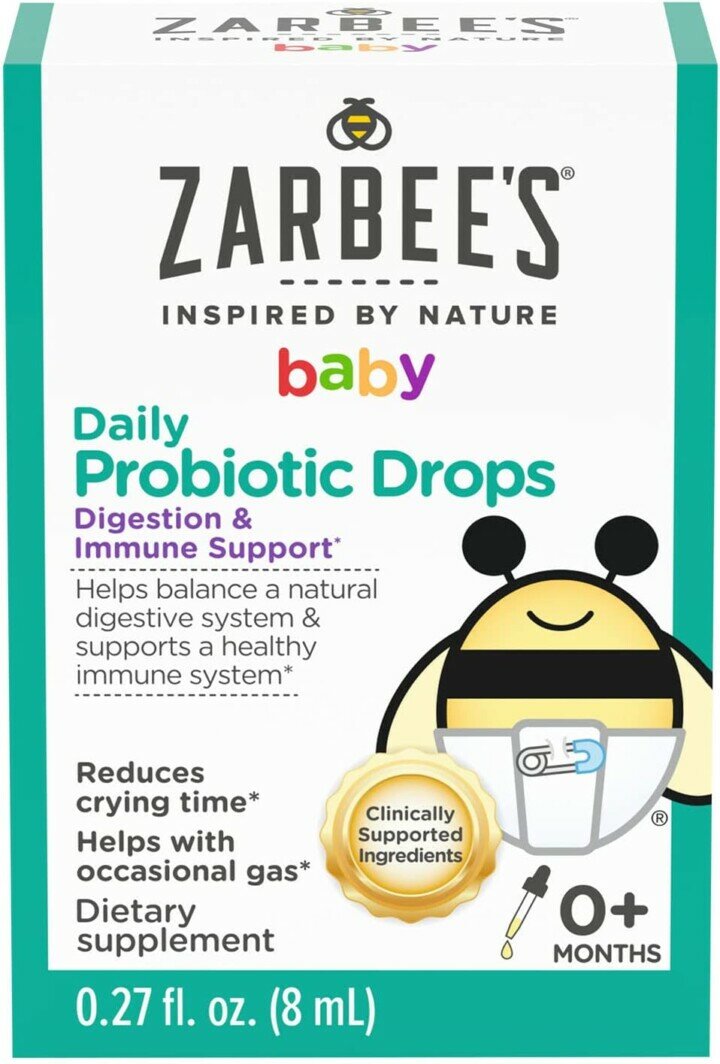
Zarbee’s Naturals Baby Daily Probiotic Drops
Key Ingredients
- Contains two probiotic strains – bifidobacterium breve BR03 and bifidobacterium breve B632, as well as corn oil
- Free from artificial sweeteners, added flavors or dyes, alcohol, high fructose corn syrup, and gluten
Why Our Experts Love it
We love so many of Zarbee’s quality products on the market, including vitamin D drops, multivitamins, and probiotic + multivitamin blends, and their Naturals Baby Daily Probiotic Drops are no different. We like these probiotic drops for gassy or colicky babies.
Pros/Cons
Pros
- Flavorless and easy to mix
- Safe and effective for daily use
Cons
- Depending on your child’s needs, you may want to switch to a different probiotic with a wider variety of probiotic strains once they reach toddlerhood
Probiotic Products
Parent’s Review
Before my pediatrician recommended probiotics, my newborn would wake up several times through the night kicking and fussing (he was also very fussy and uncomfortable during the day) because of gas. It was heartbreaking to watch as a parent. We would massage his belly, bicycle his legs, buy several bottle types to reduce air intake as he ate, I even changed my diet. After giving him probiotics regularly, he can just pass gas without any fuss and sleep peacefully. Definitely a game changer.
-MSmith

Zarbee’s Naturals Baby Daily Probiotic Drops
Zarbee’s microencapsulated probiotic blend actively helps balance a natural digestive system and are safe and effective for daily use.

Garden of Life Baby Probiotics
Key Ingredients
- Includes 7 Probiotic Strains and 4 billion active cultures – Bifidobacterium infantis Bi-26, Bifidobacterium bifidum Bb-06, Bifidobacterium longum Bl-05, Bifidobacterium lactis Bl-04, Lactobacillus rhamnosus GG, Lactobacillus acidophilus La-14, Lactobacillus reuteri 1E1), as well as organic sunflower oil and organic acacia gum
- Certified USDA Organic, Non-GMO Project Verified, and Certified Vegan
- Free from artificial flavors, sweeteners, dyes, chemicals, gluten and soy
Why Our Experts Love it
If you’re looking for a company that makes high quality products for the whole family, including baby, look no further than Garden of Life. We love this baby probiotic for its variety of probiotic strains and its clean ingredient list.
Pros/Cons
Pros
- 7 probiotic strains and 4 billion active cultures
- Certified organic and Non-GMO Project Verified
Cons
- More expensive compared to other brands
- Recommended for infants 6 + months, so will need to use something different for newborns
Probiotic Products
- Garden of Life Baby Probiotics – Infants, Babies & Toddlers
- Garden of Life Probiotics – Kids Chewables
Parent’s Review
We have long loved the Garden of Life baby probiotic. When it was out of stock at our local store, we resorted to trying another brand. It did not agree with our toddler so to the internet we went. Thanks for the prompt delivery, Garden of Life!
-Erin

Garden of Life Baby Probiotics
Help your baby build a strong digestive and immune system with a blend of clinically studied, health promoting probiotic strains, including Lactobacillus rhamnosus GG.† Garden of Life Baby Probiotics is designed for baby’s colic, gas and upset stomach.

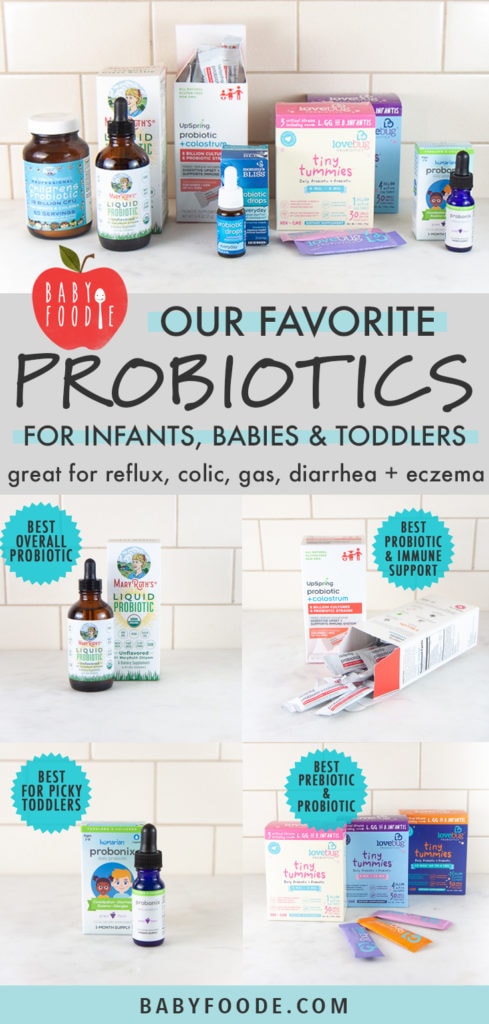
11 Comments on “Guide on Probiotics for Kids (ages 0-10)”
I’m wondering what probiotic may be recommended for babies with spit up problems. She’s not too colicky, but projectile pukes a LOT. She rarely acts distressed by it and she’s still gaining weight so her pediatrician doesn’t recommend reflux medication and says she’ll just out grow it… I have gut problems with IBS, and I’m wondering if I treat her with probiotics if they’ll help at all.
I really like the Mary Ruth probiotic and think it’s worth a try.
I really want to go with the Mary Ruth’s probiotic for my toddler AND my 6 month old. I called the pediatrician to ask for help with dosing for the baby and of course was just told she is not familiar with that one and once again was just given some bogus recommendation that I am not a fan of (Culturelle)! I like the Mary Ruth’s so I could easily just give the dropper and not need to mix anything. Any other recommendations?
Sorry that your pediatrician hasn’t heard of Mary Ruth’s, they are my favorite. They just came out with an infant probiotic, so that might be what you are looking for.
Hi there we are in Canada can you suggest some good probiotics as I searched we are getting none of the above mentioned please advice my baby is really very gassy baby I am in a need of one good probiotics.
I would try the Mary Ruth brand, as I know they ship to Canada. Good luck!
Please also remember that some FOODs naturally have probiotics as well. I love giving my baby plain greek yogurt mixed with a banana and ground oats. The yogurt contains probiotics and the banana & oats provide prebiotics (food for the probiotics) 🙂
-thoughts from a dietitian and BabyFoodie fan
Thank you for the reminder! Yes, as you mentioned some foods have natural probiotics (you can read my guide on yogurt for babies and toddlers here).
We’ve had a lot of luck with the Mary Ruth’s probiotics. We’ve been using them pretty consistently since my daughter was about 6 months old and have also used the newborn version. We had been dealing with recurrent yeast infection diaper rashes (we use cloth diapers) when we ran out and they suddenly stopped as soon as we started up with the probiotics again. It was probably just a coincidence but they also have helped a lot with preventing constipation after we started solids!
Hello love the article! Currently my son is using mommy’s bliss but I wanted to change it up to a probiotic with more strains. Is there a protocol on how to do this or can I just change the brand? I don’t want to upset my sons stomach or cause him pain. Thanks in advance!
Hi Misha! If you have concerns, I recommend contacting his doctor.